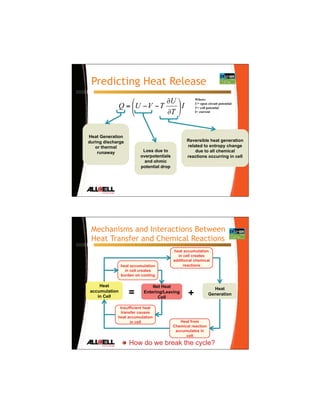
Evlib2009forum4
- 1. Predicting Heat Release Where: U= open circuit potential V= cell potential I= current Heat Generation during discharge Reversible heat generation or thermal related to entropy change runaway Loss due to due to all chemical overpotentials reactions occurring in cell and ohmic potential drop Mechanisms and Interactions Between Heat Transfer and Chemical Reactions heat accumulation in cell creates additional chemical heat accumulation reactions in cell creates burden on cooling Heat Net Heat Heat accumulation in Cell = Entering/Leaving Cell + Generation Insufficient heat transfer causes heat accumulation in cell Heat from Chemical reaction accumulates in cell How do we break the cycle?
- 2. Li-ion Battery Safety Methods Pack Level Cell Level Active Cooling Passive Cooling Cell Design Cell Chemistry Air Liquid Cooling Phase Change See Next Slide Cooling (refrigerant) Material (PCM) Electrode Shutdown Safety Safety Positive Thermal Coatings Separators Vents Circuits Coefficient Devices Ceramic Conductive Materials Polymer Cell Chemistry Electrode Electrolytes Electrode Materials Additives SEI Anode Cathode Gel Protecting Polymers Carbon Lithium Overcharge Solid Titanate Protecting Polymers (redox Shuttles) Molten Shutdown Salts Graphite Nano- Graphine Flame Retarding Platelet Composites Flammability LiCoO2 LiMn2O4 LiFePO4 LiNiO2 Oxygen “Eating” Lowering
- 3. Case Study Preventing Thermal Runaway Propagation Using Phase Change Material (PCM) What is PCM cooling? Thermal management using phase change material (PCM) – latent heat of fusion Excess heat absorbed into latent heat of melting wax No pumps, radiators, piping, or controls Prevents propagation of thermal runaway Case Study Air Cooling Simulation Thermal runaway propagation occurs due to a single cell run-away in an air-cooled module
- 4. Case Study PCM Cooling Simulation Module of 12 high energy Type 18650 cell Case 1: thermal runaway trigger of a single cell Pack Heat Generation Liquid Fraction Propagation of thermal runaway due to a single cell run-away is prevented by interstitial PCM microencapsulated in graphite Case Study PCM Cooling Simulation Module of 12 high energy Type 18650 cell Case 2: thermal runaway trigger of 2 cells Pack Heat Generation Liquid Fraction Can not prevent propagation of thermal runaway when more than 2 cells are triggered simultaneously (i.e. more PCM material or higher latent heat is needed)
- 5. Summary Safety of Li-ion batteries is a major concern Thermal Management is essential for successful commercialization of hybrid/electric vehicles Combination of various methods may be needed to optimize system design and cost Thermal amanagement with phase chnage material (PCM) is an effective alternative solution for Li-ion battery packs Discussion and Questions Acknowledgement Carrie Okma for preparing presentation slides. Contacts: Said Al-Hallaj, Chairman & CEO Tel: +1-312-235-3705 salhallaj@allcelltech.com Karen Orlich, CFO/COO Tel: +1-312-235-3702 korlich@allcelltech.com All Cell Technologies IIT University Technology Park 3440 S. Dearborn Street Suite 117N Chicago, IL 60616
- 7. EV Li-ion Battery Forum Shangai Sept. 2, 2009 Rome and Lyon Case study: Evaluating the Sodium Nickelchloride Battery value for electric urban bus transport Pres MES-DEA Lyon: Mission of ALTRA-IVECO electric buses ‡ Service 7:00AM - 10:00PM – 5 days a week ‡ Down town line 91,10 km,1 h round trip, 15’ frequency ‡ Public service on urban bus line in Lyon (F) downtown. ‡ Urban service with many stops and starts cycles charges on downtown traffic ‡ 120 Km per day for each vehicle with a complete daily service of about 50 complete trips. Energy consumption 1.1 kWh/km. Pres MES-DEA
- 8. Main Europolis BUS features ‡ 7400 x 3750 x 3100 mm ‡ Kerb weight 8740 kg ‡ GTT 12280 kg ‡ Capacity 48 Passengers ‡ Energy on board 17KWh ‡ Chargers on board with 8 hours charging time ‡ Top speed 60 km/h ‡ Max slope starting 16 % Pres MES-DEA Improvement 1: Lyon Remote Diagnostic system Pres MES-DEA
- 9. Improvement 2: New MBS software Multi Balancing Algorithm Pres MES-DEA Improvement 3: new three-phases Charger + power, - charging time, + efficiency Furthermore different BMI/MBS software improvements have been introduced. Pres MES-DEA
- 10. Lyon case study result: Dec. ’04 ~ July ’09 = 500’000Km Average = 130’000Km/year Pres MES-DEA 15 Europolis EVbus in Sorrento Italy ‡ Public service for tourists between Sorrento port and city centre. ‡ Urban service with many stops and starts cycles charges on downtown traffic ‡ 70 km per day for each vehicle ‡ 100% bus availability ‡ 102000Km covered up to July 2009 Pres MES-DEA
- 11. Rome: Mission of TECNOBUS and MES-DEA 52 electric Gulliver bus already travelling in Rome powered by lead acid battery + Other 100 electric Gulliver bus powered by ZEBRA® batteries = Rome will became one of the city with the largest electric bus fleet in Europe. Pres MES-DEA Tecnobus Gulliver vehicles: The “Gulliver” zero-emission electric bus, equipped with ZEBRA® high technology batteries, has been in regular urban service for many years further than in Italy also in several countries as England, France, Portugal, Spain, Germany and Canada with excellent results. This specific bus version works with about 70KWh and can cover about 130 km during a daily duty service even using air conditioning system. Pres MES-DEA
- 12. Gulliver capabilities in urban conditions with ZEBRA® batteries Many Gulliver bus are working in urban streets and in severe winter climatic conditions (Canada T=-40°C). Pres MES-DEA ZEBRA® Charging Efficiency Pres MES-DEA
- 13. ZEBRA® Expected Life Pres MES-DEA Battery price target For reference: If fuel price is 1.5 /l and a low fuel consumption for such a car of 4,5l/100km, a battery price of 413 /kWh or 8260 is calculated. Pres MES-DEA
- 14. Thanks for your attention! www.mes-dea.ch info@mes-dea.ch * References: - Li or Na_Full_paper_iamf 2009-Cord-Henrich Dustmann - Pure electric buses fleet in Lyon: mission, battery, energy, maintenance- Giorgio Mantovani, Fabio Nicora, Renato Manzoni Pres MES-DEA
- 15. CONFERENCE DAY TWO 3 September 2009
- 16. Examining The Li-ion Battery Needs Of Small Size City Cars For City Mobility Chetan Kumar Maini Deputy Chairman & Chief Technical Officer REVA ELECTRIC CAR India